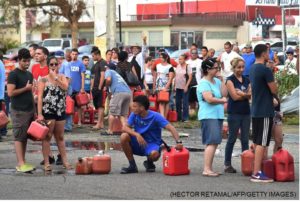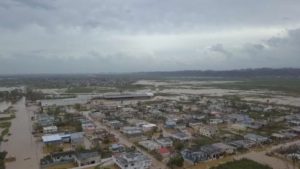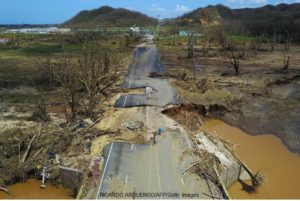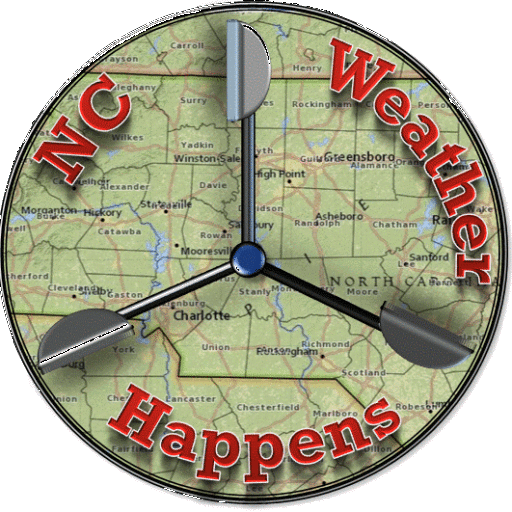What Are Learning from Hurricane Maria?
Would you be prepared for conditions like we are seeing in Puerto Rico?
Puerto Rico and the Caribbean:
As Category 5 Hurricane Maria began to threaten The Caribbean, preparations began in earnest. The warnings from weather services were dire and catastrophic damage was a certainty. With many in the storm’s path, the official forecast was quite accurate inside of 5 days and with public access to model guidance, the very wise and cautious had as much as 8 days to prepare.
 We advise all followers and subscribers to follow official forecasts from the National Hurricane Center, Storm Prediction Center, and National Weather Service. While NC Weather Happens, LLC is a private weather consulting company, we emphasize official forecasts and attempt to highlight local impacts to clients and social media.
We advise all followers and subscribers to follow official forecasts from the National Hurricane Center, Storm Prediction Center, and National Weather Service. While NC Weather Happens, LLC is a private weather consulting company, we emphasize official forecasts and attempt to highlight local impacts to clients and social media.
The current guideline from FEMA is to have 72 hours of supplies on hand should an emergency arise. Puerto Rico will be rebuilding their power grid for months and possibly years as well as infrastructure like water and sanitation. Residents will not survive without external assistance with a disaster of this magnitude. This begs the question… 
Are we prepared enough?
We asked this question to Emergency Managers around the State:
“What would happen if NC experienced devastation on the order of Puerto Rico and is the current 72 hour emergency kit still advised?”
What follows is a summary of their response and DOES NOT Replace any official preparedness recommendations. It is also important to understand we are talking about a weather related event, but preparedness can be extended to include such areas as civil unrest, war, electromagnetic pulse, or hosts of other doom and gloom unknown scenarios. Preparedness is whatever you are preparing for.
“The Current 72 Hour Kit is not nearly enough”. -FEMA
What we know:
- The island will have little to no power grid for a year or more.
- Clean water and sanitation will be extremely sparse
- Food will likely only be available through aid stations for an extended period of time.
- Medical care available now is being overwhelmed and hospitals are turning people away
- As residents endure, patience is likely to run out and lawlessness will become an issue.
 The Current guideline for preparedness:
The Current guideline for preparedness:
FEMA recommends citizens keep a 72-hour kit or stock of supplies available for everyone in the family. This includes a variety of items from:
- Food
- Water
- Medications
- Sanitary items
- Clothing
- Candles / Lanterns / Flashlights and a supply of batteries.
- Some luxury items such as books, games, toys for kids, etc…
- Necessities for pets.
Their information can be found here: https://www.fema.gov/disaster/4085/updates/building-supply-kit-your-family
The list can be as long as you want based on your family’s needs and circumstances and should get you through the most common disruptions. Those we are frequently exposed to include Ice Storms, Extended Power Outages, Flooding along the coastal plain, and wind damage.
We are proposing to you an extension of the 72-hour preparedness kit to 10 days. 
We live in a very volatile world and one may even say a powder keg waiting to go off from a short fuse! Again, this is about the weather and we ask; “would you be prepared for conditions like we are seeing in Puerto Rico?”
The short answer for Puerto Rico: The only preparedness option with a guarantee of survival, would be to leave the island before the storm. As that is not possible for the vast majority, after 3 days, we see supplies running out from their own advance preparations and more reliance on external aid.

What would a 10-day Kit look like and what would it include?
Here are some ideas to consider before hitting the stores. A Q&A section follows to help you get started.
Water:
- This is the number one item on any preparedness list. You can survive many days without food, but not more than 3 without water.
- It is recommended to have 1 gallon of water in storage for every person per day.
- A typical residential hot water heater holds 30-60 gallons of clean water. Attaching a short hose to the drain valve at the bottom, and then filtering the sediment out with a clean cloth will work just fine.
- Keep some Chlorox and / or water purification tablets on hand to keep your collected water clean.
- 5-Gallon potable water containers can be found at any camping store or outfitter. Just change the water every 6-months.
- Remember that much of your water will be used in food preparation so plan for that as you prepare your list.
Food:
A 10-day supply sounds daunting to assemble, but is not that difficult if you have a well-stocked kitchen. To begin, go to your pantry and see what you already have on hand.
- “Junk Food” is a convenience item and not used in this discussion, so if your pantry is filled with chips, soft drinks, and moon pies, you might have more work to do!
- The USDA recommends a caloric intake of between 1,000 and 3,200 calories per day. Use this number as a starting point. Read the labels to get an idea of what you have.
- Assume Frozen and Refrigerated food will spoil if not used/consumed in the first 24 hours.
- Make a list of every item and use that as your shopping list (discussed below).
Canned Food:
- A single can of prepared soup can contain 300 – 600+ calories and feed 2 people one meal.
- Check the Use-by / Sell-by dates on the product. Make sure to have the freshest products in your supply before disaster strikes.
- If the can is dented or swollen, DO NOT USE. Generally, canned food will be safe to eat for up to 2 years under ideal storage conditions in cool and dry place.
- Keep in stock only those foods you and your family enjoy!
- Examples – Soups, Dinty Moore, Tuna, Chicken, Vegetables…
Dry Goods:
- Dried beans are an excellent source of protein but require a lot of water to prepare. The cooked beans can be used to supplement a canned product chosen above for a hearty meal.
- Rice. Rice Rice Rice! Can’t stress this enough… rice is a starch and will provide a quick energy boost which may be extremely important especially in winter. It is very cheap. A 25-pound bag is less than $25 at a warehouse store. It can also be used to stretch out a good canned meal so you can reduce the amount of canned goods you are going through.
- Pasta Noodles. Pasta is another source of sugar and can be used to stretch out any meal plus it is quite filling. Keep in mind that it is also water intensive, so monitoring water usage is important with dried goods.
Prepackaged Emergency Supply Food:
- These are retail pre-packaged food kits usually dehydrated or freeze-dried.
- There are many different manufactures that you can order from.
- Wise Foods
- Mountain House
- My Patriot Supply
- Thrive
- The Church of Latter Day Saints
- Costco (online)
- They are easy to store and have a 10 – 25 year shelf life and are quite tasty.
- Look for high calorie content and low sodium as many are just too high in salt.
- All require water so your water storage needs to be robust and frequently monitored.
Convenience / Staples:
- Spices – Sugar, Iodized Salt, Pepper, Seasonings, Canned / Bottled Sauces. All of these will kick up any bland meal plus add extra minerals and calories which will be much needed in a crisis.
- Processed Food – Canned items like Spam, have a 5-year shelf life and can be prepared many different ways.
- Chocolate – Not much to add here other than having comfort food around can do wonders for one’s spirit.
- Comfort Food.
- Mac and Cheese
- Powdered milk
- Cooking Oil
- Coffee / Tea
- Hard Candy
- Peanut Butter
Medications and Vitamins.
Cash :
- A credit / debit card is useless when there is no power but having cash on hand will let you get needed supplies.
- When making a purchase, only display what is needed.
- Events longer than 10-days, precious metals become extremely valuable for exchange.
Pet Supplies:
- Pet food or if 10 days is not possible, account for pets eating some of your own supply.
- All their meds and toys.
Durable Items:
- These items will be needed to prepare food, keep things clean, and promote safety.
- Manual can opener.
- Paper Plates and utensils (so you don’t have to use your water supply to clean)
- Flashlight and supply of batteries.
- A cook stove and supply of fuel. These can be found at any outdoor section in a big box store and are relatively inexpensive.
- Disposable Lighters / Matches
- Shovel
- 5 Gallon Bucket(s) – The uses are incalculable for a 5 gallon bucket. You can store that 25 pound bag of rice in it! Use to remove debris, sanitation, haul fresh water, etc. There are entire pages on the web dedicated to their multiple uses!
- Work gloves.
- Poncho / rain suit.
- Sturdy Shoes or Boots
- Roll of plastic sheeting – this can be used as a tarp, liner for holding / collecting water, window covering…
- 100’ of Twine / Rope
- Duct Tape – As many rolls as you can store. Can be used for anything and everything.
- First Aid Kit – This can be as elaborate as you want to make it up to and including surgical grade!
- Good set of hand tools for any repairs (hammer, screw drivers, pliers, saw, loppers, etc).
- Sanitation supplies – Soap, shampoo, toothpaste, toothbrush, feminine hygiene, diapers, and toilet paper. Did I mention Toilet Paper? Remember when you run out, you have to get creative quickly, so make sure you have enough for 10 days!
- A battery or hand-cranked emergency radio.
- Card and Board games.
- Pocket knife or Multi-tool
- Heat source for winter months (kerosene heater with fuel, wood stove, etc).
- Trash bags
- Dish Soap
- Disinfecting Wipes
(Never use gas grills or camp stoves indoors and keep a fire extinguisher handy when they are in use).
Q&A:
Now I know what I have, where do I start?
Shop as you normally do at your favorite store. The only thing you will do differently is take advantage of BOGO’s. Make your purchases as you normally would, but just buy some extra, as you are able. Soon, that stockpile will grow. Look for sale items and go after them. Hygiene products can be best stored in the travel size and they are generally around a dollar. The dollar store is a great first resource to get the most bang for the buck!
Where do I store all this stuff?
Dedicate some shelves in your house, preferably in a cool dry place, and store them there. This does not have to be a massive house restoration project with a dedicated warehouse! You will be surprised how much stuff you can have on a well-organized 3-foot bookcase! Just be sure to keep your stockpile out of the elements and safe from pests. This is an investment into your survival so it needs to be protected.
I have a good 10-day supply. Now what?
If you followed the first rule, “only buy what you like to eat”, then going forward is simple. USE IT! Treat this extra supply as you would the items in your normal pantry. The only thing you will do differently is make a note of what item was removed so that it can be replaced on your next shopping trip. Keeping your stock rotated will insure that all your perishable and non-perishable items are as fresh as possible when a disaster occurs.
What about all the stuff in my Fridge and Freezer?
Unfortunately, after the first 18-24 hours, food begins to spoil or defrost. Some guidance on the web on this issue suggests having a barbecue! Before things begin to spoil, cook it as soon as it is safe to do so. Cook everything to Well-Done. Eat it. Share it. Feed the pets. Just do not get into your stockpile unless you have to. Anything left over, dispose of as you can. Remember, trash will pile up and be subject to wild animals and scavenging. Just bury the leftovers.
What happens if I run out of water and aid isn’t available?
Then you might want to look into a water purification product. I can endorse the “AlexaPure Pro” Gravity Fed Water Filtration System because I own one. It is easy to use, and the filter will last a very long time holding 2 gallons at a time. Couple this with a rainwater collection device (like the roll of plastic mentioned above) or rain barrels for your gutter, and you will have an endless supply of fresh water. It is also advisable to have a supply of water purification tablets on hand or Chlorox. ¼ teaspoon per gallon of water will disinfect your water nicely. There are many ideas out on the Web on this topic.
What happens if it looks like the disaster will be longer than 10 days?
This is a matter of what do you want to prepare for? Generally here in North Carolina, should a major disaster occur like Maria, aid from numerous sources will be flowing into shelters or distribution sites as soon as it is safe to do so. In our scenario here, we offer insight into how we can prepare for our known disasters. Many of them have lasted longer than 10 days, but they were very localized. If we look beyond this as a premise, then we are moving into “prepper” territory and beyond the scope of this article. If that is an area you wish to explore, there are some great prepper resources out there to peruse.
I live in an Apartment in the City and there just isn’t any room. Where do I put everything?
As I said above, you’ll be surprised at how much stuff you can put in a small space. You have to be creative. A plastic tub that slides under the bed can hold 60 cans of food! Just one 3-foot-long shelf can hold several weeks’ worth of pasta! You can add under-the-sink shelving for under $10 for added storage. The most difficult part is getting organized. You will find that as you clear one shelf, you have all this stuff that still needs to go somewhere. At that point you need to sort things out and let out of date items go.
I am seeing in Puerto Rico, that lawlessness is beginning to occur and it’s only been 72 hours since the storm. How do I keep my supplies from being stolen?
This is a sensitive subject and one I ask folks to consider carefully. There may be a time where you have to decide whether to keep your family alive or have your means to do so looted. Defense is a personal decision you have to make. This is beyond the scope of this article as it raises all kinds of scenarios and moral/ethical questions. So for this article, we strongly suggest you simply not tell anyone you have a stockpile and encourage those you trust to begin their own 10-day supply.
Why does FEMA suggest a 72-hour supply?
In Emergency Management, it has been observed that during the first 72 hours of a disaster, it takes a while for relief to arrive. The first 24 hours, the incident is usually still occurring and difficult to get resources in, so people need to hunker down and fend for themselves. Once the incident passes, aid is brought in, but it still may take a while before it gets to you, so the first 72 hours are critical for everyone. What you have in your 72-hour kit may be all you have until aid arrives.
This 10-day thing is overwhelming!
It shouldn’t be. Look at it like you are packing for a 2-week vacation. You know where you will be going, what you will be doing, who you will be going with, what dinners you will have… This is no different. Your house already has the most basic things already. Just look at it like camping and ask yourself, how do I cook with no stove (camping stove). How do I brush my teeth with no running water? Stored water. Where do I use the restroom? Dig a hole. The point is, everyone will be asking the same question but you will already know the answer and have a plan for it. If you really begin to think about it, virtually everything around you becomes a resource that can be used in many different ways…
Closing Thoughts:
Folks, this is just a little article to get you thinking and to ask this one question: How can I take care of my family for 10 days? The ideas presented here have been gleaned from the Internet and Emergency Managers and when put into practice, is quite easy to maintain. Once you get started, it’s also good to have a practice night. Everyone in the family gets a “lights out drill”. No phones. No TV. It’s ok to use plumbing but just make sure everyone knows what do to if the bathroom were not available. Get out the camp stove and prepare a meal outside. Read stories by candle light or play a game…make sure all the candles are out and the stove is cool, then turn in for the night. Take notes of what worked or needs improvement. Then improve on it and repeat until you are satisfied.
In no time, you will find yourself prepared. Once you are confident that your 10-day supply will keep you and your family safe, then you can go after those “prepper” scenarios if you wish.
Be sure to get our Free App from the App Store!



